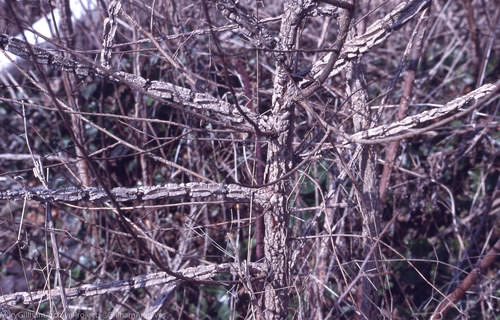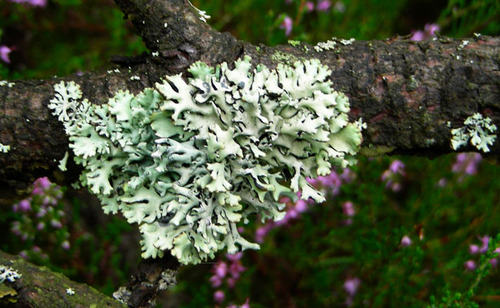6.11 菌菌共生
章节大纲
-
What killed this tree?
::是什么杀死这棵树的?Dutch elm trees used to be common, beautiful trees in the United States. Now most of them, like this tree, have been killed by Dutch elm disease. Dutch elm disease is caused by a . This is just one example of how fungi can interact with other species .
::荷兰的精灵树曾经在美国很常见,美丽的树。现在,大部分像这棵树一样,它们已经被荷兰的精灵病杀死。荷兰的精灵病是由一个原因引起的。这只是真菌与其他物种互动的一个例子。Symbiotic Relationships with Fungi
::与真菌的共生关系Fungi don't live in isolation. They often interact with other species. In fact, fungi can be dependent on another organism for survival. When two species live close together and form a relationship, it is called . Symbiosis can be beneficial to one or both organisms, or sometimes one organism hurts the other. Some of the partners in these relationships include plants, , and other animals , and even humans.
::蘑菇并不孤立地生活。 它们经常与其他物种互动。 事实上, 真菌可以依赖另一个生物体生存。 当两个物种紧密地生活在一起并形成一种关系时, 它被称为 。 共生性可以对一个或两个生物体都有益, 或者有时一个生物体伤害另一个生物体。 这些关系中的一些伙伴包括植物, 和其他动物, 甚至人类。Fungi and Plants
::菌类和植物If it were not for fungi, many plants would go hungry. In the soil , fungi grow closely around the roots of plants, and they begin to help each other. The plant roots together with the special root-dwelling fungi are called mycorrhizae ( Figure ).
::如果不是真菌,许多植物会挨饿。在土壤中,真菌在植物的根部附近生长,它们开始互相帮助。植物根和特殊的根栖真菌被称作“灭菌 ” 。As plants and fungi form a close relationship, the plant and the fungus “feed” one another. The plant provides sugars to the fungus that the plant makes through , which the fungus cannot do. The fungus then provides minerals and water to the roots of the plant. Since the plant and the fungus are helping each other out, this is a mutualistic relationship , a type of symbiosis known as mutualism . In a mutualistic relationship, both organisms benefit.
::随着植物和真菌形成密切的关系,植物和真菌“相互喂养”了。植物为植物经过的真菌提供糖,而真菌无法做到。真菌为植物的根部提供矿物和水。由于植物和真菌相互帮助,这是一种相互性的关系,一种被称为相互共存的共生关系。在相互性的关系中,两种生物都受益。These roots (brown) and the mycorrhizae (white) help to feed one another.
::这些树根(褐色的)和小白的(白的)树枝(白的)能互相喂养。Lichens
::厕所Have you ever seen an organism called a lichen ? Lichens are crusty, hard growths that you might find on trees, logs, walls, and rocks ( Figure ). Although lichens may not be the prettiest organisms in nature, they are unique. A lichen is really two organisms, sometimes referred to as a composite organism, that live very closely together: a fungus and a bacterium or an alga. The cells from the alga or bacterium live inside the fungus. Besides providing a home, the fungus also provides nutrients . In turn, the bacterium or the alga provides energy to the fungus by performing photosynthesis, obtaining energy directly from the sun. A lichen is also an example of a mutualistic relationship. Because lichens can grow on rocks, these organisms are some of the earliest life forms in new .
::你见过一个叫地衣的有机体吗?柳木是结壳,在树、木头、墙壁和岩石上可能发现的硬生长物(Figure ) 。虽然地衣可能不是自然界最漂亮的有机体,但它们是独一无二的。地衣其实是两种有机体,有时被称为复合有机体,非常密切地生活在一起:真菌和细菌或藻类;藻类或细菌的细胞生活在真菌中;真菌除了提供家舍外,还提供营养。反过来,细菌或藻类通过光合作,直接从太阳获取能量,为真菌提供能量。地衣也是相互关系的一个例子。由于地衣可以生长在岩石上,这些生物是新生命形式中最早期的一部分。This tree is covered in lichen, a symbiotic relationship between a fungus and a bacterium or an alga.
::这棵树覆盖在地衣里, 一种真菌和细菌或藻类之间的共生关系。Fungi and Insects
::菌类和昆虫Many insects have a symbiotic relationship with certain types of fungi:
::许多昆虫与某些种类的真菌有共生关系:-
Ants and termites grow fungi in underground “fungus gardens” that they create. When the ants or termites have eaten a big meal of wood or leaves, they also eat some fungi from their gardens. The fungi help them digest the wood or leaves. The fungi secrete certain
enzymes
that the ants or termites cannot produce on their own.
::蚂蚁和白蚁在他们创造的地下“蘑菇园”里生长真菌。当蚂蚁或白蚁吃了一顿大餐木或叶子的时候,他们也吃园里的真菌。真菌帮助他们消化木或叶子。真菌分泌蚂蚁或白蚁不能自己生产的某些酶。 -
Ambrosia beetles live in the bark of trees. Like ants and termites, they grow fungi inside the bark of trees and use it to help digest their food.
::安布罗西亚甲虫生活在树皮中,它们像蚂蚁和白蚁一样,在树皮中生长真菌,用它来消化食物。
Fungi as Parasites
::蘑菇作为寄生虫Although lots of symbiotic relationships help both organisms, sometimes one of the organisms is harmed. When that happens, the organism that benefits, and is not harmed, is called a parasite . This type of relationship is known as parasitism .
::尽管许多共生关系对这两种生物都有帮助,但有时其中一种生物受到伤害。 当这种情况发生时,受益而且没有受到伤害的有机体被称为寄生虫。 这种关系被称为寄生虫。Examples of parasitic fungi include the following:
::寄生真菌的例子包括:-
Beginning in 1950, Dutch Elm trees in the United States began to die. Since then, most of these trees have been eliminated. The disease was caused by a fungus that acted as a parasite. The fungus that killed the trees was carried by beetles to the trees.
::从1950年开始,美国的荷兰精灵树开始死亡,自那以后,这些树大多被消灭了,这种疾病是由作为寄生虫的真菌引起的。 杀死树木的真菌被甲虫带到树上。 -
Some parasitic fungi cause human diseases such as athlete’s foot and ringworm. These fungi feed on the outer layer of warm, moist skin. Though its name may suggest otherwise, ringworm is not caused by a worm, but by a fungus.
::有些寄生虫真菌导致人体疾病,比如运动员脚和虫。 这些真菌在温暖潮湿皮肤的外层喂食。 尽管其名称可能表明情况并非如此,但并不是由蠕虫引起的,而是由真菌引起的。
Summary
::摘要-
Fungi can form a mutualistic relationship with photosynthetic organisms, including plants, bacteria, and algae.
::菌菌可以与植物、细菌和藻类等光合生物形成相互关系。 -
Fungi can also be parasites of trees and people.
::菌类也可能是树木和人的寄生虫。
Review
::回顾-
What is a lichen?
::什么是衣架? -
Describe the mutualistic relationship within a lichen.
::描述地衣内部的相互关系。 -
Describe a symbiotic relationship between fungi and insects.
::描述真菌和昆虫之间的共生关系。 -
Give an example of a fungal parasite in humans.
::举一个例子 人类中的真菌寄生虫
-
Ants and termites grow fungi in underground “fungus gardens” that they create. When the ants or termites have eaten a big meal of wood or leaves, they also eat some fungi from their gardens. The fungi help them digest the wood or leaves. The fungi secrete certain
enzymes
that the ants or termites cannot produce on their own.


